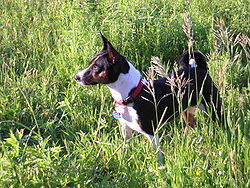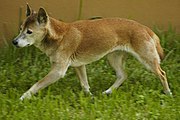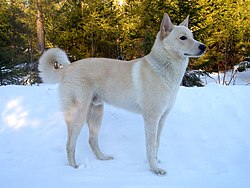
The Basenji is a breed of hunting dog that was bred from stock originating in central Africa. Most of the major kennel clubs in the English-speaking world place the breed in the Hound Group; more specifically, it may be classified as belonging to the sighthound type. The Fédération Cynologique Internationale places the breed in Group 5, Spitz and Primitive types, and the United Kennel Club (US) places the breed in the Sighthound & Pariah Group.
The Basenji produces an unusual yodel-like sound, due to its unusually shaped larynx. This trait also gives the Basenji the nickname "Barkless Dog." In behavior and temperament they have some traits in common with cats.[citation needed]
Basenjis share many unique traits with Pariah dog types. Basenjis, like dingos and some other breeds of dog, come into estrus only once annually, as compared to other dog breeds which may have two or more breeding seasons every year. Both dingos and Basenjis lack a distinctive odor,[citation needed] and both are considered relatively silent,[citation needed] more prone to howls, yodels, and other undulated vocalizations over the characteristic bark of modern dog breeds. While dogs that resemble the basenji in some respects are commonplace over much of Africa, the breed's original foundation stock came from the old growth forest regions of the Congo Basin, where its structure and type were fixed by adaptation to its habitat, as well as use (primarily net hunting in extremely dense old-growth forest vegetation).
Appearance

Tri-colour with brindle points
Basenji are small, elegant-looking, short-haired dogs with erect ears, a tightly curled tail, and a graceful neck. Some people consider their appearance similar to that of a miniature deer. A basenji's forehead is wrinkled, especially when the animal is young. Basenji eyes are typically almond shaped, which gives the dog the appearance of squinting seriously.
Dogs typically weigh 24 pounds (11 kg) and stand 16 inches (40.6 cm) at the withers. They are typically a square breed, which means that they are as long as they are tall. The basenji is an athletic dog and is deceptively powerful for its size. They have a graceful, confident gait like a trotting horse, and skim the ground in a "double-suspension gallop", with their characteristic curled tail straightened out for greater balance, when running flat-out at their top speed.
The basenji is recognized in the following standard colorations: red, black, tricolor (black with tan in the traditional pattern), and brindle (black stripes on a background of red), all with white, by the FCI, KC, AKC, and UKC. There are additional variations, such as the "trindle", which is a tricolor with brindle points, and several other colorations exist in the Congo such as liver, shaded reds and(sables), "capped" tricolors (creeping tan).
Temperament

A basenji standing on its hind legs to look over a wall
The Basenji is alert, affectionate, energetic, and curious and reserved with strangers. The Basenji is somewhat aloof, but can also form strong bonds with people. Basenjis may not get along with non-canine pets. It is usually patient, but does best with older considerate handlers. Basenjis dislike wet weather, like to climb, can easily get over chain wire fences, and are very clever at getting their own way. The Basenji has the unique properties of not barking (it makes a low, liquid ululation instead) and cleaning itself like a cat. It can be described as speedy, frisky, tireless at play, and teasing the owner into play. Most Basenji problems usually involve a mismatch between owner and pet. Basenjis often stand on their hind legs, somewhat like a meerkat, by themselves or leaning on something. This behavior is often observed when the dog is curious about something.
Health

Very young basenji puppies
There is apparently only one completed health survey of basenjis, a 2004 UK Kennel Club survey.
Many basenjis suffer from PRA (progressive retinal atrophy), which causes blindness, and Fanconi's syndrome, which can cause kidney failure. Besides Fanconi Syndrome and PRA, Basenjis also suffer from Hypothyroidism, IPSID (immunoproliferative systemic intestinal disease), HA (Hemolytic Anemia). Basenjis are also sensitive to environmental and household chemicals which can cause liver problems.
Mortality
Basenjis in the 2004 UK Kennel Club survey had a median longevity of 13.6 years (sample size of 46 deceased dogs), which is 1–2 years longer than the median longevity of other breeds of similar size. The oldest dog in the survey was 17.5 years. Most common causes of death were old age (30%), urologic (incontinence, Fanconi syndrome, chronic kidney failure 13%), behavior ("unspecified" and aggression 9%), and cancer. (9%).
Morbidity
Among 78 live dogs in the 2004 UKC survey, the most common health issues noted by owners were dermatologic and urologic (urologic issues in basenjis can be signs of Fanconi syndrome).
Fanconi Syndrome
Fanconi syndrome, an inheritable disorder in which the kidneys fail to reabsorb electrolytes and nutrients, is unusually common in basenjis. Symptoms include excessive drinking, excessive urination, and glucose in the urine, which may lead to a misdiagnosis of diabetes. Fanconi syndrome usually presents between 4 and 8 years of age, but sometimes as early as 3 years or as late as 10 years. Fanconi syndrome is treatable and organ damage is reduced if treatment begins early. Basenji owners are advised to test their dog's urine for glucose once a month beginning at the age of 3 years. Glucose testing strips designed for human diabetics are inexpensive and available at most pharmacies.
[edit] Fanconi DNA Linkage Test
In July 2007, Dr. Gary Johnson of the University of Missouri released the linked marker DNA test for Fanconi Syndrome in basenjis. It is the first predictive test available for Fanconi Syndrome. With this test, it is possible to more accurately determine the probability of a dog carrying the gene for Fanconi Syndrome.
Dogs tested using this "Linkage Test" will return one of the following statuses:
-
- Indicates the individual has most likely inherited normal DNA from both parents. It is unlikely that basenjis which test this way will produce affected puppies no matter which dog they are bred to.
- Indicates the individual has most likely inherited normal DNA from one parent and DNA with the Fanconi syndrome mutation from the other parent. Although this basenji is unlikely to develop Fanconi syndrome, it could produce puppies that will develop Fanconi syndrome. To minimize the chances of this happening it is recommended carriers be bred only to those that test as Probably Clear/Normal for Fanconi Syndrome.
- Probably Equivocal/Indeterminant
- Indicates the individual's DNA contained features found in both "normal" and "carrier" basenjis. At present it cannot be predicted whether these basenjis are carriers or normal; however, it is unlikely that they will develop Fanconi syndrome. The safest strategy would be to treat them as “carriers” and only bred to those basenjis that test as Probably Clear/Normal for Fanconi Syndrome.
- Indicates the individual is likely to develop clinical Fanconi syndrome and is likely to produce puppies with Fanconi Syndrome if bred to basenjis other than those that test as Probably Clear/Normal for Fanconi Syndrome.
This linkage test is being provided as a tool to assist breeders whilst research continues towards the development of the direct fanconi test.
For more information about the linkage test visit: Basenji Health Endowment Fanconi Test FAQ.
Other basenji health issues
Basenjis sometimes carry a simple recessive gene which, when homozygous for the defect, causes genetic Hemolytic Anemia.[8] Most 21st-century basenjis are descended from ancestors that have tested clean. When lineage from a fully tested line (set of ancestors) cannot be completely verified, the dog should be tested before breeding. As this is a non-invasive DNA test, a basenji can be tested for HA at any time.
Basenjis sometimes suffer from hip dysplasia, resulting in loss of mobility and arthritis-like symptoms. All dogs should be tested by either OFA or PennHIP prior to breeding.
Malabsorption, or immunoproliferative enteropathy, is an autoimmune intestinal disease that leads to anorexia, chronic diarrhea, and even death. A special diet can improve the quality of life for afflicted dogs.
The breed can also fall victim to progressive retinal atrophy (a degeneration of the retina causing blindness) and several less serious hereditary eye problems such as coloboma (a hole in the eye structure), and persistent pupillary membrane (tiny threads across the pupil).
History

A brindle Basenji
The basenji is arguably one of the most ancient dog breeds. Originating on the continent of Africa, basenji-like dogs have lived with humans for thousands of years. Dogs resembling modern Basenjis can be seen on stelae in the tombs of Egyptian pharaohs, sitting at the feet of their masters, looking just as they do today, with pricked ears and tightly curled tails. Dogs of this type were originally kept for hunting small game by coursing.
Europeans first described the type of dog from which the basenji breed was derived in the Congo in 1895. These local dogs, which Europeans identified as a unique breed and called "basenji" were prized by locals for their intelligence, courage, speed, and silence. However an article published called The Intelligence of Dogs by Stanley Coren, Ph.D. questions this. It ranks the breed at #78 out of 79 which is the second to lowest rank in intelligence. Many question the qualifications of this article and whether it accurately evaluates each breed. In fact, Dr. Coren equated "intelligence" with "obedience", and the basenji is not the most obedient of breeds because of its intelligence. Therefore, the veracity of Dr. Coren's findings is questionable.
Basenjis were assistants to the hunt, chasing wild game into nets for their masters. The Azande and Mangbetu people from the northeastern Congo region describe basenjis, in the local Lingala language, as mbwá na basɛ́nzi. Translated, this means "dogs of the savages", or "dogs of the villagers". In the Congo, the basenji is also known as "dog of the bush." The dogs are also known to the Azande of southern Sudan as Ango Angari. The word basɛ́nzi itself is the plural form of mosɛ́nzi. In Kiswahili, another Bantu language, from East Africa, mbwa shenzi translates to “wild dog”. Another local name is m’bwa m’kube m’bwa wamwitu, or “jumping up and down dog”, a reference to their tendency to jump straight up to spot their quarry.
Several attempts were made to bring the breed to England, but the earliest imports succumbed to disease. In 1923, for example, Lady Helen Nutting brought six basenjis with her from Sudan, but all six died from distemper shots they received in quarantine.[10] It was not until the 1930s that foundation stock was successfully established in England, and then to the United States by animal importer Henry Trefflich. So it is that nearly all the basenjis in the Western world are descended from these few original imports. The breed was officially accepted into the AKC in 1943. In 1990, the AKC stud book was reopened to several new imports at the request of the Basenji Club of America. Basenjis are also registered with the UKC.
Although in the past it was speculated that Basenjis were somehow descended from jackals, modern genetic testing shows that Basenjis are related to all other dogs and are descended from the wolf, Canis lupus.[citation needed]
Basenjis in popular culture
The title character of the 1954 novel Good-bye, My Lady, by James H. Street, is a basenji. It's the story of a young boy in Mississippi who takes in a most unusual stray. The book was made into a movie of the same name in 1956, with a cast that included Brandon De Wilde, Walter Brennan, and Sidney Poitier.
Veronica Anne Starbuck's 2000 novel Heart of the Savannah features a basenji named Savannah. Savannah narrates this story about her adventures as an African-bred dog brought to America. Starbuck also wrote a sequel titled August Magic.
Simon Cleveland wrote a novel titled The Basenji Revelation, published by Lulu Press in 2004, in which a government agent suffers amnesia and undergoes a change in personality after inheriting a basenji from his late mother. The book delivers insightful facts about the ancient origins of the breed.
The true story of a basenji was featured in the episode The Cat Came Back on the radio program This American Life. The segment tells the story of a family who chose a basenji because they do not shed or slobber, but became frustrated with his aloofness and destructiveness. They eventually bring him to live on a farm 30 miles (48 km) away, but within a few days the tenacious dog found its way all the way back home.
In Spike Milligan's War Diaries "Mussolini: His Part in My Downfall" (Sept 24, 1943) the following exchange takes place:
...we are bloody lost. Lt. Budden is looking studiously at his map, the wrong way up.
"It's upside down, Sir."
"I know that, I turned it upside down for a reason."
"Sorry, Sir, only trying to help."
"If you want to help, Milligan, act like a basenji."
According to the webcomic Achewood, if Jesus Christ were a dog, he'd be a basenji.
A man and his Basenji were featured on an episode of LA Ink. The basenji has an unusual marking of a diamond in the middle of his back. The owner has a replica tattooed on his own back during the episode.
Basenjis are featured in an episode of the animated television series The Wild Thornberrys In episode 3.04 "Tyler Tucker, I Presume?", Nigel Thornberry encounters a group of tribesmen along with their Congolese hunting dogs.
The basenji was featured on CBS's early show during Dog Week: http://www.youtube.com/watch?v=B3FAU2a0Roc
 The Bavarian Mountain Hound is a breed of dog from Germany. It is a scent hound and has been used in Germany since the Middle Ages to trail wounded game. It is a cross between the Bavarian Hound, and the Hanover Hound.
The Bavarian Mountain Hound is a breed of dog from Germany. It is a scent hound and has been used in Germany since the Middle Ages to trail wounded game. It is a cross between the Bavarian Hound, and the Hanover Hound.

















